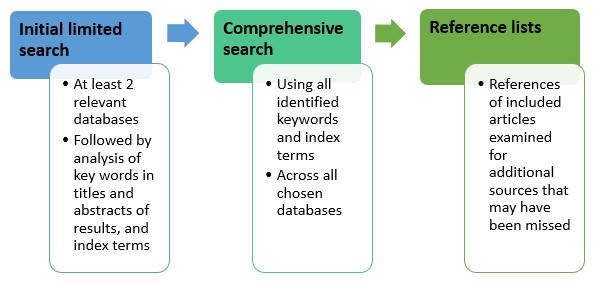
This page is a general overview of scoping and systematic reviews. For more detailed information, please see the following resources.
Describes the methodology for creating a protocol and conducting a scoping review.
Describes in detail the process of preparing and maintaining Cochrane systematic reviews on the effects of healthcare interventions.
Here you can access information about the PRISMA reporting guidelines, which are designed to help authors transparently report why their systematic review was done, what methods they used, and what they found.
Library resources
Describes each step of the review process, with links to resources, tools and key articles
Covidence is a tool designed to streamline the review process from title & abstract screening through to data extraction. It allows review teams to significantly reduce the time spent of reviews to produce evidence much faster.
 Introducing scoping and systematic reviews by Erin Roga and Dr Karen Pruis
Introducing scoping and systematic reviews by Erin Roga and Dr Karen Pruis
If you need further support, book an appointment with a librarian.
A systematic or scoping review aims to find all available evidence, has a distinct methodology, and follows a structured process.
Scoping reviews have a broad question and aim to identify and map the amount and type of evidence.
Systematic reviews have a specific question and aim to collect and combine all the evidence in an unbiased way.
 Introducing scoping and systematic reviews: Introduction to reviews
Introducing scoping and systematic reviews: Introduction to reviews
Developing the review question is the first step of planning a review, and will depend on the aims of the review. There may be sub-questions as well. Frameworks can help develop a clear and focused question.
| PICO is usually used for systematic reviews |
PCC is usually used for scoping reviews |
 |
 |
The search strategy for a review aims to find all possible evidence. JBI recommends a three step process.

Search techniques such as Boolean operators, phrase searching, truncation, wildcards and proximity operators are used to ensure the search is comprehensive.
It is also useful to document the development of the search to keep track of your decisions. It can also help when reporting the search methods as all the required information is readily available.
The results of the search are screened according to the inclusion and exclusion criteria. 
The remaining articles will be those included in the review.
The PRISMA flow diagram documents how the included articles were chosen. If Covidence is used for screening, this is created automatically.
Covidence is a tool designed to streamline the review process from title & abstract screening through to data extraction. It allows review teams to significantly reduce the time spent of reviews to produce evidence much faster.
The flow diagram depicts the flow of information through the different phases of a systematic review. It maps out the number of records identified, included and excluded, and the reasons for exclusions.
Data extraction is sometimes called charting in scoping reviews. The data needed from each included study to answer the review question is found.
What data is extracted depends on the type of review and the question. Some common items include the population, the outcomes, the context and the findings.
Critical appraisal, or risk of bias, is done to assess if a study can be trusted. It is not required for all review types, such as scoping reviews. It is typically performed for each included study in a systematic review.
There are many tools and checklists available that can be used for critical appraisal.
JBI’s critical appraisal tools assist in assessing the trustworthiness, relevance and results of published papers.
Checklists and notes to aid critical appraisal
Checklists to help you more easily and accurately perform critical appraisal across a number of different study types.
Synthesising brings together and presents the results of all included studies. How this is done will depend on the type of review and the question.
The results can be presented using a narrative or thematic approach, presented in tables or graphs, or even as infographics.
PRISMA (Preferred Reporting Items for Systematic Reviews and Meta-Analyses) is a checklist to help authors report reviews in a replicable and transparent way. There are extensions for different sections of a review, such as the search and abstract, for protocols, and for different review types, such as scoping reviews.
The PRISMA 2020 Statement, and the Extension and Elaboration gives further details about what should be reported on for each item.
The PRISMA flow diagram is used to report on the process of how many records were found, how many were excluded, and how many are included in the review.
Here you can access information about the PRISMA reporting guidelines, which are designed to help authors transparently report why their systematic review was done, what methods they used, and what they found.
20 essential reporting items and 2 optional items to include when completing a scoping review.

